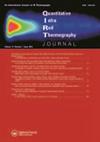A robust optical flow motion estimation and correction method for IRT imaging in brain surgery
IF 4.9
3区 工程技术
Q1 INSTRUMENTS & INSTRUMENTATION
引用次数: 6
Abstract
ABSTRACT In brain surgery, respiration motion, outliers, and occlusions create artefacts in Infrared Thermography (IRT) imaging. In this paper, we propose a robust method to handle multiple motion, outliers, and occlusions in IRT images which consists of two phases: preprocessing and image motion estimation. In the preprocessing phase, the Region of Interest (RoI) segmentation is employed to extract the brain cortex only. Thereafter, the Phase Correlation method is employed to compensate for large motion followed by occlusion masking based on an approach applying Cellular Nonlinear Networks (CNN). Next, intensity adjustment is made with respect to the reference image. Then, a Gaussian filter is applied. In the following phase, the image motion is estimated by employing Combined Local-Global (CLG) optical flow method. In order to find the best regularization coefficient for the spatial coherency term and the number of iterations for recursive optical flow estimation, we generated ground truth and evaluated the accuracy of the estimated motion vectors based on Average Angular Error (AAE) and Average Magnitude Error (AME). The efficiency improvement of the proposed method was tested on 1024 IRT images based on different comparisons. Thereby, the proposed method shows promising results for motion estimation and correction application in brain surgery.一种用于脑外科IRT成像的稳健光流运动估计和校正方法
在脑外科手术中,呼吸运动、异常值和闭塞会在红外热成像(IRT)成像中产生伪影。在本文中,我们提出了一种鲁棒的方法来处理IRT图像中的多运动、异常点和遮挡,该方法包括两个阶段:预处理和图像运动估计。在预处理阶段,感兴趣区域(RoI)分割仅用于提取大脑皮层。然后,基于细胞非线性网络(CNN)的方法,采用相位相关方法补偿大运动后的遮挡。接下来,强度调整是相对于参考图像。然后,应用高斯滤波器。在接下来的阶段,采用联合局部-全局(CLG)光流法估计像移。为了找到空间相干项的最佳正则化系数和递归光流估计的迭代次数,我们基于平均角误差(AAE)和平均星等误差(AME)生成了地真值,并对估计的运动矢量的精度进行了评估。基于不同的对比,在1024张IRT图像上测试了该方法的效率提高。因此,该方法在脑外科运动估计和校正应用中具有良好的效果。
本文章由计算机程序翻译,如有差异,请以英文原文为准。
求助全文
约1分钟内获得全文
求助全文
来源期刊

Quantitative Infrared Thermography Journal
Physics and Astronomy-Instrumentation
CiteScore
6.80
自引率
12.00%
发文量
17
审稿时长
>12 weeks
期刊介绍:
The Quantitative InfraRed Thermography Journal (QIRT) provides a forum for industry and academia to discuss the latest developments of instrumentation, theoretical and experimental practices, data reduction, and image processing related to infrared thermography.
 求助内容:
求助内容: 应助结果提醒方式:
应助结果提醒方式:


